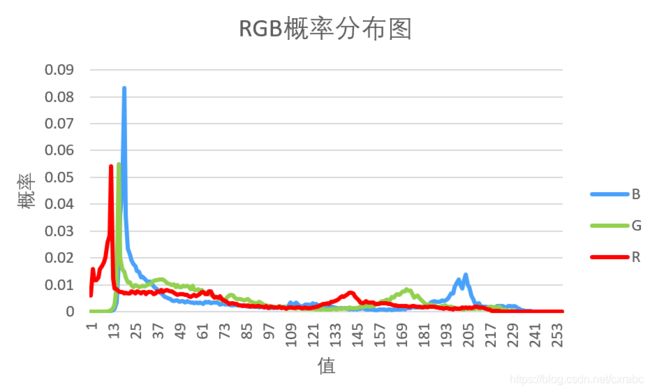分析rgb和yuv文件的三个通道的概率分布,并计算各自的熵(编程实现)。
文章目录
- 一、实验任务
- 二、实验思路
- 三、代码部分
-
- 1.rgb
- 2.yuv
- 四、结果分析
-
- 1.rgb的熵及概率分布图
- 2.yuv的熵及概率分布图
- 3.结论
一、实验任务
分析rgb和yuv文件的三个通道的概率分布,并计算各自的熵(编程实现)。
注:
1. down.rgb和down.yuv两个文件的分辨率均为256*256。
2. yuv为4:2:0采样空间。
3. 存储格式:rgb文件按每个像素BGR分量依次存放;YUV格式按照全部像素的Y数据块、U数据块和V数据块依次存放。
二、实验思路
1. 分别读取R、G、B(或Y、U、V)到数组中。
- RGB文件 按每个像素BGR分量依次存放。
- YUV文件 按照全部像素的Y数据块、U数据块和V数据块依次存放。本实验为4:2:0采样空间。
4:2:0是指水平和垂直 Y 各取样两个点,UV 各只取样一个点,水平的取样比例是 2:1,重直的取样比例 2:1,也就是色度和亮度差 1/2 * 1/2 = 1/4。
2. 分别统计R、G、B(或Y、U、V)三通道的颜色强度级的频数。
3. 别计算R、G、B(或Y、U、V)三通道的颜色强度级的概率,将概率写入文件。
4. 计算熵并输出。

三、代码部分
1.rgb
代码如下:
#include2.yuv
代码如下:
#include四、结果分析
将编程得到的txt文件导入Excel表格中,绘制图像。
1.rgb的熵及概率分布图
| 分量 | R | G | B |
|---|---|---|---|
| 熵 | 7.22955 | 7.17846 | 6.85686 |
2.yuv的熵及概率分布图
| 分量 | Y | U | V |
|---|---|---|---|
| 熵 | 6.331819 | 5.126402 | 4.113143 |
3.结论
观察RGB与YUV的概率分布图,可以看出YUV分量的值更不均匀,所以它的熵更小。该结论与编程计算的熵的结果相符。



